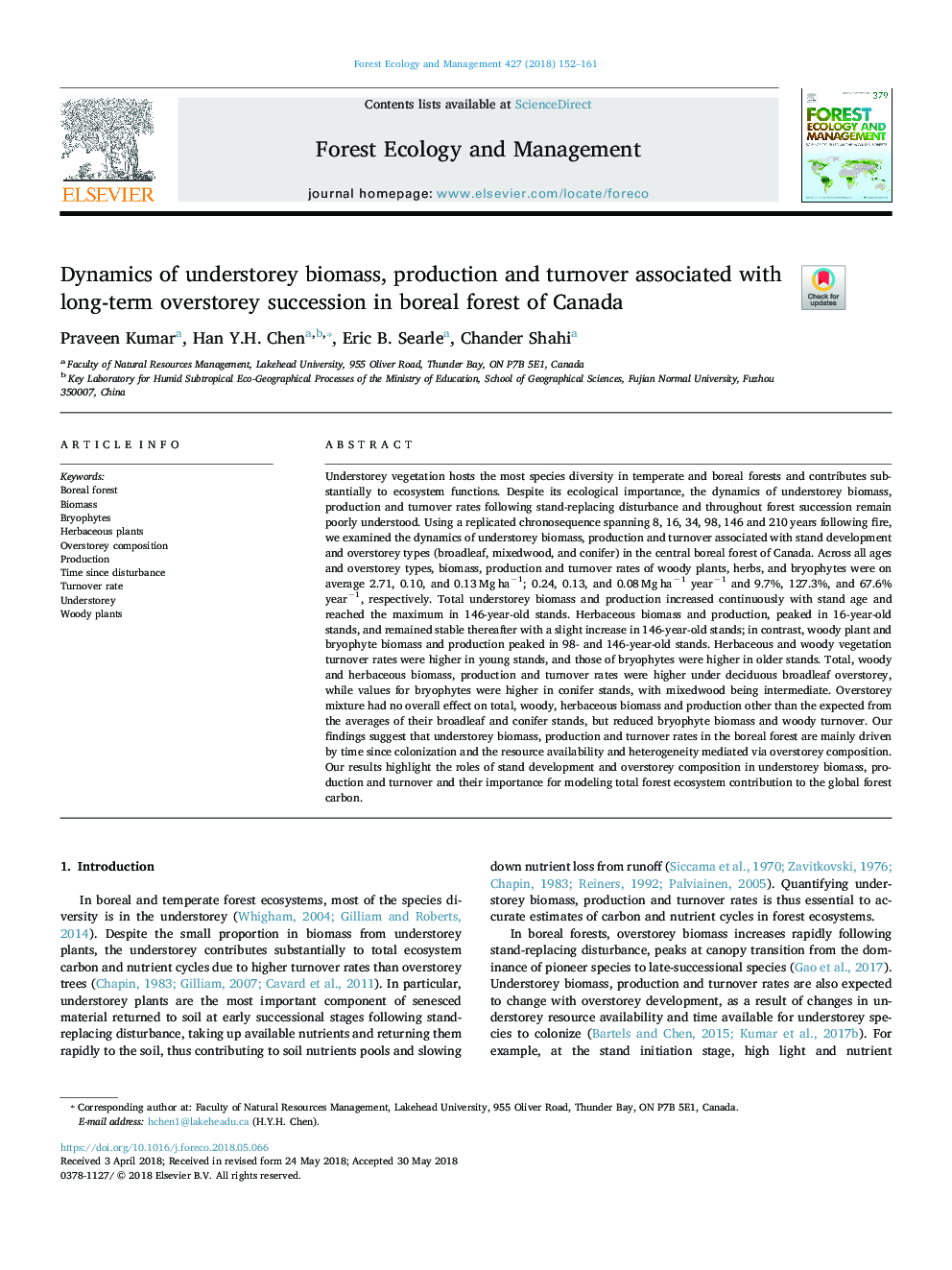| کد مقاله | کد نشریه | سال انتشار | مقاله انگلیسی | نسخه تمام متن |
|---|---|---|---|---|
| 6541505 | 1421333 | 2018 | 10 صفحه PDF | دانلود رایگان |
عنوان انگلیسی مقاله ISI
Dynamics of understorey biomass, production and turnover associated with long-term overstorey succession in boreal forest of Canada
ترجمه فارسی عنوان
دینامیک زیست توده دودی، تولید و جابجایی مرتبط با جانشینی طولانی مدت در جنگل های بومی کانادا
دانلود مقاله + سفارش ترجمه
دانلود مقاله ISI انگلیسی
رایگان برای ایرانیان
کلمات کلیدی
جنگل نابالغ، زیست توده، بریوفیت، گیاهان علفی، ترکیب بیش از حد، تولید، زمان از اختلال، نرخ گردش، معذرت خواهی گیاهان وودی،
موضوعات مرتبط
علوم زیستی و بیوفناوری
علوم کشاورزی و بیولوژیک
بوم شناسی، تکامل، رفتار و سامانه شناسی
چکیده انگلیسی
Understorey vegetation hosts the most species diversity in temperate and boreal forests and contributes substantially to ecosystem functions. Despite its ecological importance, the dynamics of understorey biomass, production and turnover rates following stand-replacing disturbance and throughout forest succession remain poorly understood. Using a replicated chronosequence spanning 8, 16, 34, 98, 146 and 210â¯years following fire, we examined the dynamics of understorey biomass, production and turnover associated with stand development and overstorey types (broadleaf, mixedwood, and conifer) in the central boreal forest of Canada. Across all ages and overstorey types, biomass, production and turnover rates of woody plants, herbs, and bryophytes were on average 2.71, 0.10, and 0.13â¯Mgâ¯haâ1; 0.24, 0.13, and 0.08â¯Mgâ¯haâ1 yearâ1 and 9.7%, 127.3%, and 67.6% yearâ1, respectively. Total understorey biomass and production increased continuously with stand age and reached the maximum in 146-year-old stands. Herbaceous biomass and production, peaked in 16-year-old stands, and remained stable thereafter with a slight increase in 146-year-old stands; in contrast, woody plant and bryophyte biomass and production peaked in 98- and 146-year-old stands. Herbaceous and woody vegetation turnover rates were higher in young stands, and those of bryophytes were higher in older stands. Total, woody and herbaceous biomass, production and turnover rates were higher under deciduous broadleaf overstorey, while values for bryophytes were higher in conifer stands, with mixedwood being intermediate. Overstorey mixture had no overall effect on total, woody, herbaceous biomass and production other than the expected from the averages of their broadleaf and conifer stands, but reduced bryophyte biomass and woody turnover. Our findings suggest that understorey biomass, production and turnover rates in the boreal forest are mainly driven by time since colonization and the resource availability and heterogeneity mediated via overstorey composition. Our results highlight the roles of stand development and overstorey composition in understorey biomass, production and turnover and their importance for modeling total forest ecosystem contribution to the global forest carbon.
ناشر
Database: Elsevier - ScienceDirect (ساینس دایرکت)
Journal: Forest Ecology and Management - Volume 427, 1 November 2018, Pages 152-161
Journal: Forest Ecology and Management - Volume 427, 1 November 2018, Pages 152-161
نویسندگان
Praveen Kumar, Han Y.H. Chen, Eric B. Searle, Chander Shahi,
